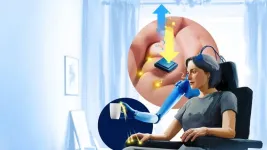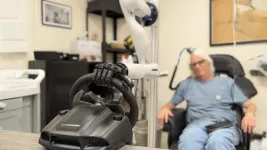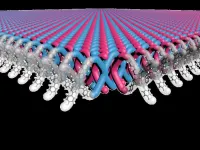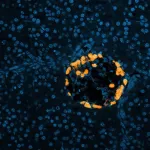(Press-News.org) For the first time ever, a complex sense of touch for individuals living with spinal cord injuries is a step closer to reality. A new study published in Science, paves the way for complex touch sensation through brain stimulation, whilst using an extracorporeal bionic limb, that is attached to a chair or wheelchair.
The researchers, who are all part of the US-based Cortical Bionics Research Group, have discovered a unique method for encoding natural touch sensations of the hand via specific microstimulation patterns in implantable electrodes in the brain. This allows individuals with spinal cord injuries not only to control a bionic arm with their brain, but also to feel tactile edges, shapes, curvatures and movements, that until now have not been possible.
“In this work, for the first time the research went beyond anything that has been done before in the field of brain-computer interfaces (BCI) – we conveyed tactile sensations related to orientation, curvature, motion and 3D shapes for a participant using a brain-controlled bionic limb. We are in another level of artificial touch now. We think this richness is crucial for achieving the level of dexterity, manipulation, and a highly dimensional tactile experience typical of the human hand,” says Giacomo Valle, lead author of the study and Assistant Professor at Chalmers University of Technology, in Sweden.
The importance of the sense of touch
A sense of touch builds richness and independence in our everyday lives. For individuals living with a spinal cord injury, the electrical signals coming from the hand to the brain that should allow an individual to feel tactile sensations, are being blocked by the injury and that sense of touch is lost. A bionic limb controlled by user’s brain signals can bring back some functionality and independence to someone with a paralysed hand, but without the sense of touch, it is very difficult to lift, hold and manipulate objects. Previously, a bionic hand would not be perceived by the user as part of the body, since it would not provide any sensory feedback like a biological hand. This study aimed to improve the usability of an extracorporeal bionic limb, which would be mounted on a wheelchair or similar equipment close by to the user.
Implantable technology for controlling bionic limbs with the brain
For the study, two BCI participants were fitted with chronic brain implants in the sensory and motor regions of the brain that represent the arm and hand. Over the course of several years, the researchers were able to record and decode all of the different patterns of electrical activity that occurred in the brain related to motor intention of the arm and hand. This was possible, since the electrical activity was still present in the brain, but the paralysis was blocking this from reaching the hand. Decoding and deciphering brain signals with this technology is unique and allows the participants to directly control a bionic arm and hand with the brain for interacting with the environment.
Complex touch typed into the brain
The participants were able to accomplish a series of complex experiments, that require rich tactile sensations. To do this, the researchers typed specific stimulations directly into the users’ brain via the implants.
“We found a way to type these ‘tactile messages’ via microstimulation using the tiny electrodes in the brain and we found a unique way to encode complex sensations. This allowed for more vivid sensory feedback and experience while using a bionic hand,” says Valle.
The participants could feel the edge of an object, as well as the direction of motion along the fingertips.
By utilising the Brain Computer Interface, the researchers could decode the intention of motion from the participant’s brain in order to control a bionic arm. Since the bionic arm has sensors on it, when an object comes into contact with these sensors, the stimulation is sent to the brain and the participant feels the sensation as if it were in their hand. This means that the participants could potentially complete complex tasks with a bionic arm with more accuracy than was previously possible, like picking up an object and moving it from one location to another.
The future of complex touch for neural prosthetics
This research is just the first step towards patients with spinal cord injuries being able to feel this level of complex touch. To capture all the features of complex touch that the researchers are now able to encode and convey to the user, more complex sensors and robotic technology is needed (for example prosthetic skin). The implantable technology used to stimulate, would also require development, to increase the repertoire of sensation.
More about the research:
The study “Tactile edges and motion via patterned microstimulation of the human somatosensory cortex” published in Science, was led by Giacomo Valle, who is now Assistant Professor at the Department of Electrical Engineering at Chalmers University of Technology in Sweden, and who was active with a team at the University of Chicago in the Bensmaia Lab, USA, at the time of the study.
More about Cortical Bionics Research Group:
This area of research is already of major business interest in the USA, with multiple research institutions, and also private companies, now starting to commercialise implantable neurotechnology Part of the system being used for this study is now being developed by an American neurotech company. But there is less happening in Europe where the different regulatory landscape could impact the translation of emerging neurotechnologies. This study brings Chalmers into the Cortical Bionics Research Group and aims to establish a European hub for this area of neurotech research.
The Cortical Bionics Research Group is made up of three north American Universities – University of Pittsburgh, University of Chicago and Northwestern University. The mission of the Cortical Bionics Research Group is to build next-generation intracortical Brain-Computer Interfaces that enable dexterous control of bionic hands by people with paralysis or amputation.
Illustration caption: An illustration showing a paralyzed individual with a spinal cord injury, implanted with intracortical electrodes in the brain. This brain-computer interface (BCI) allows the individual to control a bionic limb that is not attached to the body, directly with thoughts, to reach and grasp a coffee mug. Due to embedded sensors, the bionic hand senses the grasped object as if it were being grasped with the human hand, communicating the touch sensations to the user’s brain via advanced neurostimulation.
Illustration credit: Chalmers University of Technology | Boid | David Ljungberg
For more information, please contact:
Giacomo Valle, Assistant Professor at the Department of Electrical Engineering, Chalmers University of Technology, Sweden, +46 70 83 88 515 valleg@chalmers.se
Charles Greenspon, Research Assistant Professor at the Department of Organismal Biology & Anatomy, University of Chicago, USA, +1 312 88 94 029 cmgreenspon@uchicago.edu
The contact persons speak English They are available for live and pre-recorded interviews. At Chalmers, we have podcast studios and broadcast filming equipment on site and would be able to assist a request for a television, radio or podcast interview. The BCI participants in America are available for interview through Giacomo Valle.
More about the scientific article:
The article, Tactile edges and motion via patterned microstimulation of the human somatosensory cortex, was published in Science.
The researchers involved in the study are Giacomo Valle, Ali H. Alamri, John E. Downey, Robin Lienkämper, Patrick M. Jordan, Anton R. Sobinov, Linnea J. Endsley, Dillan Prasad, Michael L. Boninger, Jennifer L. Collinger, Peter C. Warnke, Nicholas G. Hatsopoulos, Lee E. Miller, Robert A. Gaunt, Charles M. Greenspon, Sliman J. Bensmaia.
At the time of the study, the researchers were active at University of Chicago, USA; Chalmers University of Technology, Sweden; University of Pittsburgh, USA; and Northwestern University, USA.
The research was funded by the National Institute of Neurological Disorders and Stroke of the National Institutes of Health under Award Number UH3NS107714 to R.A.G., by R35 NS122333 to S.J.B. and by the University of Chicago (Chicago Postdoctoral Fellowship) to G.V.
You can read a recent Nature article that has been written about the study here.
- The study won the world-wide prestigious award for innovative BCI applications by gTec.
- The company developing part of the system that was used in the study and the researchers' industrial partner can be found here.
- BCI participants association involved can be found here.
- BCI network of worldwide experts in which the researchers collaborate can be found here.
- patent submitted on the presented neurotech: “GV is an inventor on a pending international (PCT) patent application submitted by The University of Chicago and The University of Pittsburgh that covers multi-channel microstimulation of the somatosensory cortex (n. 23-0518-WO)"
END
Most advanced artificial touch for brain-controlled bionic hand
2025-01-16
ELSE PRESS RELEASES FROM THIS DATE:
Compounding drought and climate effects disrupt soil water dynamics in grasslands
2025-01-16
A novel field experiment in Austria reveals that compounding climate conditions – namely drought, warming, and elevated atmospheric carbon dioxide (CO2 ) – could fundamentally reshape how water moves through soils in temperate grasslands. The findings provide new insights into post-drought soil water flow, in particular. Soil water, though a minuscule fraction of Earth's total water resources, plays a critical role in sustaining terrestrial life on Earth by regulating biogeochemical cycles, surface energy balance, and plant productivity. Soils also govern ...
Multiyear “megadroughts” becoming longer and more severe under climate change
2025-01-16
Severe droughts are becoming hotter, longer, and increasingly devastating to ecosystems as climate change accelerates, according to a new study, which reports that temperate grasslands, including in parts of the United States, are facing the worst effects. The findings provide a global quantitative understanding of multiyear droughts (MYDs) – prolonged events lasting years or decades – and offer a benchmark for understanding their global trends and impacts. As droughts become more frequent ...
Australopithecines at South African cave site were not eating substantial amounts of meat
2025-01-16
Seven Australopithecus specimens uncovered at the Sterkfontein fossil site in South Africa were herbivorous hominins who did not eat substantial amounts of meat, according to a new study by Tina Lüdecke and colleagues. Lüdecke et al. analyzed organic nitrogen and carbonate carbon isotopes extracted from tooth enamel in the fossil specimens to determine the hominin diets. Some researchers have hypothesized that the incorporation of animal-based foods in early hominin diets led to increased brain size, smaller gut size ...
An AI model developed to design proteins simulates 500 million years of protein evolution in developing new fluorescent protein
2025-01-16
Guided by a multimodal generative language model called ESM3, Thomas Hayes and colleagues generated and synthesized a previously unknown bright fluorescent protein, with a genetic sequence so different from known fluorescent proteins that the researchers say its creation is equivalent to ESM3 simulating 500 million years of biological evolution. The model could provide a new way to “search” the space of protein possibilities with an eye to better understanding how naturally evolved proteins work, as well as developing novel proteins for uses in medicine, environmental remediation, and a host of other applications. ESM3 can reason over protein ...
Fine-tuned brain-computer interface makes prosthetic limbs feel more real
2025-01-16
You can probably complete an amazing number of tasks with your hands without looking at them. But if you put on gloves that muffle your sense of touch, many of those simple tasks become frustrating. Take away proprioception — your ability to sense your body’s relative position and movement — and you might even end up breaking an object or injuring yourself.
“Most people don’t realize how often they rely on touch instead of vision — typing, walking, picking up a flimsy cup of water,” said Charles Greenspon, PhD, a neuroscientist at the University of Chicago. “If you can’t feel, you have ...
New chainmail-like material could be the future of armor
2025-01-16
EVANSTON, Il. --- In a remarkable feat of chemistry, a Northwestern University-led research team has developed the first two-dimensional (2D) mechanically interlocked material.
Resembling the interlocking links in chainmail, the nanoscale material exhibits exceptional flexibility and strength. With further work, it holds promise for use in high-performance, light-weight body armor and other uses that demand lightweight, flexible and tough materials.
Publishing on Friday (Jan. 17) in the journal ...
The megadroughts are upon us
2025-01-16
Increasingly common since 1980, persistent multi-year droughts will continue to advance with the warming climate, warns a study from the Swiss Federal Institute for Forest, Snow, and Landscape Research (WSL), with Professor Francesca Pellicciotti from the Institute of Science and Technology Austria (ISTA) participating. This publicly available forty-year global quantitative inventory, now published in Science, seeks to inform policy regarding the environmental impact of human-induced climate change. It also detected previously ‘overlooked’ events.
Fifteen years of a persistent, devastating megadrought—the longest lasting in a thousand years—have nearly dried out ...
Eavesdropping on organs: Immune system controls blood sugar levels
2025-01-16
When we think about the immune system, we usually associate it with fighting infections. However, a study published in Science by the Champalimaud Foundation reveals a surprising new role. During periods of low energy—such as intermittent fasting or exercise—immune cells step in to regulate blood sugar levels, acting as the “postman” in a previously unknown three-way conversation between the nervous, immune and hormonal systems. These findings open up new approaches for managing conditions like diabetes, obesity, and cancer.
Rethinking the Immune ...
Quantum engineers ‘squeeze’ laser frequency combs to make more sensitive gas sensors
2025-01-16
The trick to creating a better quantum sensor? Just give it a little squeeze.
For the first time ever, scientists have used a technique called “quantum squeezing” to improve the gas sensing performance of devices known as optical frequency comb lasers. These ultra-precise sensors are like fingerprint scanners for molecules of gas. Scientists have used them to spot methane leaks in the air above oil and gas operations and signs of COVID-19 infections in breath samples from humans.
Now, in a series of lab experiments, researchers have laid out a path for making those kinds of measurements even more sensitive and faster—doubling the speed of ...
New study reveals how climate change may alter hydrology of grassland ecosystems
2025-01-16
New research co-led by the University of Maryland reveals that drought and increased temperatures in a CO2-rich climate can dramatically alter how grasslands use and move water. The study provides the first experimental demonstration of the potential impacts of climate change on water movement through grassland ecosystems, which make up nearly 40% of Earth’s land area and play a critical role in Earth’s water cycle. The study appears in the January 17, 2025, issue of the journal Science.
“If we want to predict the effects of climate change ...







